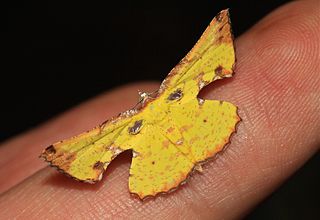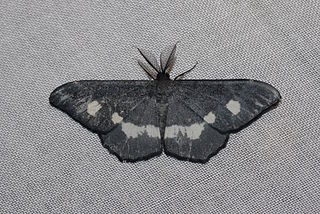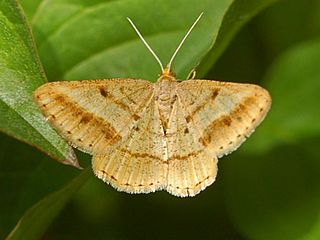
Biston is a genus of large, long-winged moths belonging to the family Geometridae. It is most notable for containing the well-known peppered moth. The genus was first described by William Elford Leach in 1815.

Ophthalmitis is a genus of geometer moths in the Boarmiini tribe.

Agathia is a genus of moths in the family Geometridae described by Achille Guenée in 1858.

Amblychia is a genus of moths in the family Geometridae described by Achille Guenée in 1857.

Corymica is a genus of moths in the family Geometridae described by Francis Walker in 1860.

Derambila is a genus of moths in the family Geometridae first described by Francis Walker in 1863.

Cyclophora is a genus of moths in the family Geometridae. Many species are referred to as mochas in reference to their colouration, primarily in Europe.

Eucrostes is a genus of moths in the family Geometridae. It was erected by Jacob Hübner in 1823.

Hemithea is a genus of moths in the family Geometridae erected by Philogène Auguste Joseph Duponchel in 1829. In 1999 there were about 31 species in the genus.

Hyperythra is a genus of moths in the family Geometridae. It was erected by Achille Guenée in 1857.

Hyposidra is a genus of moths in the family Geometridae first described by Achille Guenée in 1857.

Isturgia is a genus of moths in the family Geometridae described by Jacob Hübner in 1823.
Nadagara is a genus of moths in the family Geometridae first described by Francis Walker in 1861.
Pomasia is a genus of moths in the family Geometridae.

Problepsis is a genus of moths in the family Geometridae.

Sauris is a genus of moths in the family Geometridae erected by Achille Guenée in 1857.
Scardamia is a genus of moths in the family Geometridae.

Synegia is a genus of moths in the family Geometridae. It was described by Achille Guenée in 1857.

Thalassodes is a genus of moths in the family Geometridae first described by Achille Guenée in 1857.

Timandra is a genus of moths in the family Geometridae first described by Philogène Auguste Joseph Duponchel in 1829.
















